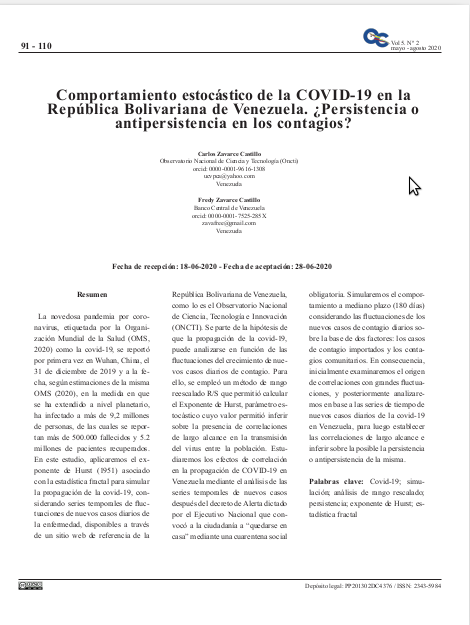Stochastic behavior of covid-19 in the Bolivarian Republic of Venezuela: persistence or anti-persistence in infections?
Keywords:
Covid-19, simulation, rescaled range analysis, persistence analysis, Hurst exponent, fractal statisticsAbstract
The novel coronavirus pandemic, labeled by the World Health Organization (WHO) as Covid-19, was first reported in Wuhan, China, on December 31, 2019. To date, according to the WHO's estimates, it has infected more than 9.2 million people, of whom more than 500,000 are reported dead, and 5.2 million patients have recovered. To deepen in its study, we apply the Hurst exponent, associated with fractal statistics to simulate the spread of Covid-19, considering time series of fluctuations of new daily cases, which are available in a site reference website of the Bolivarian Republic of Venezuela, such as the National Observatory for Science, Technology, and Innovation (ONCTI). This work starts from the hypothesis that the spread of Covid-19 can be analyzed based on the fluctuations in the increase of new daily cases. For this, an R / S rescaled range method was used that allowed calculating the Hurst Exponent, a stochastic parameter whose value allowed inferring the presence of long-range correlations in the virus transmission among the population. We will study the correlation effects in the spread of COVID-19 in Venezuela by analyzing the time series of new cases after the alert decree issued by the Executive branch, which called on citizens to "stay at home" through a mandatory social quarantine. Consequently, initially, we will examine the origin of correlations with large fluctuations, followed by an analysis based on the time series of new daily cases of Covid-19 in Venezuela, in order to establish the long-range correlations and infer about the possible persistence or anti persistence of it.
Downloads
References
Davies, RB y Harte, DS (1987). Tests for Hurst effect. Biometrika 74:95-101.Recuperado en: http://robertnz.net/pdf/hursteffect.pdf
Garmendia S, Alcaide, A. (2011). ¿Es el Coeficiente de Hurst un Buen Indicador de Extinción de Especies? Pensamiento Matemático. Recuperado en: https://www.researchgate.net/publication/267231306_Es_el_coeficiente_de_Hurst_un_buen_indicador_de_extincion_de_especies
Hurst, H.E. (1951). Long-term storage capacity of reservoirs. Transactions of the American Society of Civil Engineers. 116: 770. Recuperado en: https://cedb.asce.org/CEDBsearch/record.jsp?dockey=0292165
Mandelbrot, B. (1982). The Fractal Geometry of Nature, 2nd. ed. W. H. San Francisco: Freeman & Co
Organización Mundial de la Salud (2010): ¿Qué es el periodo pospandémico? Recuperado en : https://www.who.int/csr/disease/swineflu/frequently_asked_questions/post_pandemic/es/ .
Racine, R. (2011). Estimating the Hurst Exponent. UD y la Geomática. Recuperado en: http://revistas.udistrital.edu.co/ojs/index.php/UDGeo/article/view/3648/68
Thom, R. (1977). Stabilit éstructurelle et morphogénèse, París: Interédition

Downloads
Published
How to Cite
Issue
Section
License
Copyright (c) 2023 Carlos Zavarce Castillo, Fredy Zavarce Castillo

This work is licensed under a Creative Commons Attribution-NoDerivatives 4.0 International License.







